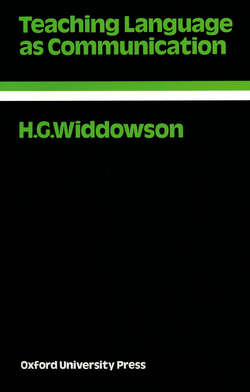Teaching Language as Communication

Реклама. ООО «ЛитРес», ИНН: 7719571260.
Оглавление
H. G. Widdowson. Teaching Language as Communication
Introduction
1 Usage and use
1.1 Correctness and appropriacy
1.2 Usage and use as aspects of performance
1.3 Usage and use in classroom presentation
1.4 Aspects of meaning: signification and value
1.5 Usage and use in the design of language teaching materials
1.6 Selecting areas of use for teaching language
1.7 Summary and conclusion
2 Discourse
2.1 Sentence, proposition and illocutionary act
2.2 Cohesion and propositional development
2.3 Coherence and illocutionary development
2.4 The relationship between propositional and illocutionary development
2.5 Procedures of interpretation
2.6 Deriving discourse from sentences: an example
2.6.1 Propositional development: achieving cohesion
2.6.2 Illocutionary development: achieving coherence
2.7 Conventions of coherence
2.8 Deriving discourse by arrangement: another example
2.9 Summary and conclusion
3 Linguistic skills and communicative abilities
3.1 The four skills
3.2 Activities associated with spoken language
3.3 Activities associated with written language
3.4 Reciprocal and non-reciprocal activities
3.5 Linguistic skills and communicative abilities
3.6 Retrospective and prospective interpretation
3.7 Assimilation and discrimination
3.8 Non-verbal communication
3.9 Summary and conclusion
4 Comprehending and reading
4.1 Preview
4.2 The reading passage as dependent exemplification
4.3 The reading passage as independent ‘comprehension piece’
4.3.1 Extracts: the problem of authenticity
4.3.2 Extracts: the comprehending problem
4.3.2.1 Priming glossaries
4.3.2.2 Prompting glossaries
4.3.3 Simplified versions
4.3.4 Simple accounts
4.4 Gradual approximation
4.5 Comprehension questions: forms and functions
4.5.1 Types of question by reference to form
4.5.2 Types of question by reference to function
4.5.2.1 Usage reference
4.5.2.2 Use inference
4.6 Other reading exercises18
5 Composing and writing
5.1 Preview
5.2 Types of grammar exercise
5.3 Exercises in usage and use
5.3.1 Composing sentences in passages
5.3.2 Using the contexts of the reading passage
5.4 Preparation exercises
5.5 Exploitation exercises
5.5.1 Gradual approximation: sentence to discourse units
5.5.2 Gradual approximation: act to discourse units
5.5.2.1 Focus on single illocutionary acts
5.5.2.2 Relationships between pairs of acts
5.5.2.3 Extension to larger discourse units
5.5.3 Rhetorical transformation of discourse units
5.5.4 Information transfer
5.6 Summary and conclusion
6 Towards an integrated approach
6.1 Preview: the need for integration
6.2 The discourse-to-discourse scheme
6.3 Types of procedure
6.3.1 Demonstration: rhetorical transformation by gradual approximation
6.3.2 Demonstration: rhetorical transformation by illocutionary change
6.3.3 Demonstration: information transfer
6.4 Principles of approach
6.4.1 Rational appeal: the use of translation
6.4.2 Integration and control
6.5 Summary and conclusion
Отрывок из книги
This book is an attempt to clarify certain issues that seem to me to arise from adopting a communicative approach to the teaching of language. I have in mind, in particular, the teaching of English to speakers of other languages. Over recent years I (and a number of others) have advocated such an approach in principle and have tried to put it into practice in the preparation of teaching materials. In principle and practice, however, there always seemed to be loose ends of one sort or another: inconsistencies, unexamined assumptions, unresolved difficulties. My aim in this book was to sort out some of the things that I had been saying, consider their implications more closely, and see if they might be ordered into a coherent account. I wanted to try to think things through.
The ‘communicative’ approach is, of course, very much in vogue at present. As with all matters of fashion, the problem is that popular approbation tends to conceal the need for critical examination. There seems to be an assumption in some quarters, for example, that language is automatically taught as communication by the simple expedient of concentrating on ‘notions’ or ‘functions’ rather than on sentences. But people do not communicate by expressing isolated notions or fulfilling isolated functions any more than they do so by uttering isolated sentence patterns. We do not progress very far in our pedagogy by simply replacing abstract isolates of a linguistic kind by those of a cognitive or behavioural kind. If we are seriously interested in an approach to language teaching which will develop the ability to communicate, then we must accept the commitment to investigate the whole complex business of communication and the practical consequences of adopting it as a teaching aim. Such a commitment involves, I believe, a consideration of the nature of discourse and of the abilities that are engaged in creating it. This is the main concern of the first part of this book. The commitment involves, too, an attempt to think out the possible pedagogic procedures which will lead the learner towards the ability to handle discourse. The second part of the book represents such an attempt. I do not claim that in either part I have done any more than open up a number of possibilities. Our present state of knowledge about language and language learning is such that it would be irresponsible to be anything but tentative. But it would be even more irresponsible to avoid investigation and to pretend that there are no problems.
.....
Making an appropriate reply is a matter of selecting a sentence which will combine with the sentence used for asking the question. Or it may involve using only part of a sentence, as in the second of the normal exchanges given above.
The learning of a language, then, involves acquiring the ability to compose correct sentences. That is one aspect of the matter. But it also involves acquiring an understanding of which sentences, or parts of sentences are appropriate in a particular context. The first kind of ability depends upon a knowledge of the grammatical rules of the language being learned. We can demonstrate this knowledge by producing strings of sentences without regard to context:
.....